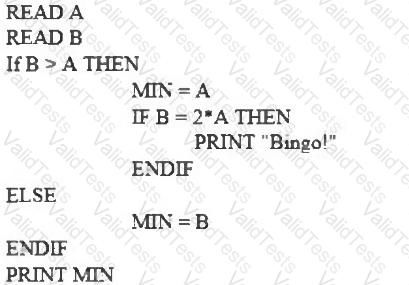Given the following decision: IF X < 5 OR Y > 10 THEN
Which of the following sets of test inputs will achieve full MC/DC coverage?
You are an experienced tester on an Agile team that is producing a new application. The product backlog has been refined sufficiently to begin development for the first release. This stories in this backlog contain a mixture of functional and non-functional requirements, as well as some technical stories that will provide elements of the application's infrastructure The developers have decided to use TDD as a deveiopment approach but automation of the acceptance tests is not yet planned.
You have been asked to recommend whether or not the team should take an atdd approach as well as TDD. what would be the BEST recommendation in these circumstances?
SELECT ONE OPTION
Which TWO of the following could be identified using Dynamic Analysis?
A) Objects having too much or too little visibility into parent classes.
B) Repetition of code within a single component or module.
C) System memory not released when it is no longer needed.
D) Pointers in a program that are no longer accurate and must not be used. E. Code that cannot be reached and so will not be executed.
The stakeholders in a new system want its mean time between failure to be three months or longer, with a mean time to repair the system of ten minutes or less when it does fail. When planning and specifying reliability tests to be performed before release, which ONE of the following is a factor that must be considered?
The following epic has been written:
As a vehicle driver
I want to find an available space In a car park
So that I can pay in advance to reserve that space
This epic will be used to develop user stories for a new National Car Parking application Both public and private car park owners will be able to utilise the system, allowing drivers of all kinds to guarantee an available car parking space on arrival at their chosen car park, according to the kind of vehicle that they may drive
There will be multiple stakeholders including different car park owners, different user groups including disabled drivers and different vehicle types such as car. van and motorbike.
From this epic, multiple user stories will be written. The following acceptance criteria have been written for the epic, and will be applicable to all user stories (each user story will also have its own acceptance cntena):
1.End-to-end response time for any individual request submitted by a user must not exceed 5 seconds
2.All correspondence with stakeholders must be via email and text message
3.The application must be accessible on most mobile technology
4.A user cannot submit a form unless all mandatory fields are entered
5.Payment method can be made using the most popular electronic options
Applying the INVEST technique to this epic, including its acceptance criteria, which of the following statements is correct?
SELECT ONE OPTION
You are ar teviemng the fdbwng Java furxton that deteimates whether a curb*. rput by the user. * Even or Odd Public da»s Oddorfven {
public state void mair^Strcg [ | args) (
Scarcer read - new ScanrerfSystem inje
System out prim (’Pease enter a rxmber'i;
int Number • reader nextfntO,
if(Number^2»»0)
System out prrrtln "your input number 'Number ♦ * is even ).
else
System out prntirfyour input number 'Number ♦ * is odd*);
)
}
You are Qj>ded by ’.he following checklist
•All variables must start with a Capital letter
•All output messages must start with a Capita letter
•There must De a comment bne e« pla ning the purpose of the dess
How many checklist items Mve been fuelled7
SELECT ONE OPTION
Consider the pseudo code provided below regarding a customer request for cash withdrawal from an ATM.
If the customer has sufficient funds in their account
OR the customer has the credit granted
THEN the ATM machine pays out the requested amount to the customer
Which of the following test cases would be the result of applying multiple condition testing, but would NOT be the result of applying modified condition/decision testing?
Consider the pseudo code provided below:

Given the following tests, what additional test(s) (if any) would be needed in order to achieve 100% statement coverage, with the minimum number of tests?
Test 1: A = 7, B = 7, Expected output: 7
Test 2: A = 7, B = 5, Expected output: 5
Consider the simplified logic below for crediting money to a bank account.
Receive money and account number to be credited
IF account number is valid
IF customer account is active
Store current account balance as oldBalance
Credit money to account
IF oldBalance < zero
IF balance now >= zero
Set message "Overdraft cleared"
ELSE
Set message "A/c overdrawn"
ENDIF
ELSE
Set message = "You have more money"
ENDIF
IF account holder is VIP customer
Send message by email to customer
ENDIF
ELSE
Set message "A/c inactive"
Send message by email to supervisor
ENDIF
ELSE
Add 1 to count of invalid inputs
ENDIF
What percentage of decision testing coverage has been achieved by the following suite of test cases?
Test Case A - Account number valid, account is active, oldBalance = -100, balance now = +200, not a VIP customer
Test Case B - Account number valid, account is active, oldBalance = -100, balance now = -50, is a VIP customer
You have been assigned to perform a review on code provided below:

Which type of defect should you report as part of the code review?